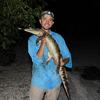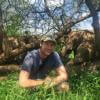Human-wildlife conflict is a shockingly common problem, often with enormous consequences for both individual animals and entire populations.
When human-wildlife conflict comes to mind, you may immediately think of wildlife crime instead - which isn't wrong, since many regions with wildlife crime problems like poaching are also areas where people may frequently deal with human-wildlife conflict, causing the two issues to go hand-in-hand. But human-wildlife conflict is a much broader issue encompassing many ways that human presence and interference can cause problems for us and animals alike. Human-wildlife conflict includes:
- Elephants trampling a farmer's crops, resulting in retaliation
- New real estate developments infringing on ecosystems where predator species live, leading to predators having less territory and less food, which in turn leads to predators attacking domestic animals and livestock
- Freeways dividing the territory of animals like mountain lions, leading to wildlife venturing into neighborhoods or being killed by cars
- Lead bullets used in hunting causing scavengers like condors to die of lead poisoning
These are just a few examples of how humans can negatively impact wildlife, and it's clear to see how many of these scenarios could escalate. Human-wildlife conflict solutions don't just include ways in which we can prevent these issues (for example, through tracking predators, monitoring populations' territories, or building barriers and wildlife crossings monitored by sensors), but also the ways in which we can help people connect with wildlife and care about learning to live alongside them.
If you're interested in solutions that can prevent human-wildlife conflict, join this group and get to know the people who are working to protect and save species around the world!
Header image: Casey Allen on Unsplash
- @jmasseloux
- | She/Her
Programme Coordinator and M&E Specialist at ZSL Thailand

- 0 Resources
- 3 Discussions
- 2 Groups
- 0 Resources
- 0 Discussions
- 10 Groups
- @emilyhuston
- | she/her/hers
Hi! I am currently pursuing a masters degree in wildlife conservation and management, and I am looking to gain more information and form connections with people who are interested in all the same things :)
- 0 Resources
- 0 Discussions
- 6 Groups
- @GrecoBobby
- | He/Him
PhD Student Clemson University. Investigating applied management techniques in crocodilians
- 0 Resources
- 0 Discussions
- 4 Groups
Conservation Director, Texas with National Audubon Society
- 0 Resources
- 4 Discussions
- 3 Groups
Margo Supplies - Wildlife Technology



- 0 Resources
- 39 Discussions
- 3 Groups
MSc student in wildlife management and conservation


- 0 Resources
- 2 Discussions
- 12 Groups
Zoological Society London (ZSL)
Technical Project Manager in ZSL's Conservation Technology Unit



- 2 Resources
- 26 Discussions
- 7 Groups
Universidad San Francisco de Quito
Biologist/Professor focusing on carnivore conservation in Ecuador
- 0 Resources
- 0 Discussions
- 12 Groups
- 0 Resources
- 0 Discussions
- 6 Groups
- @Phillip_Swart
- | He
I'm a conservationist working in the Vulture conservation space in South Africa with a huge passion for technology.
- 0 Resources
- 0 Discussions
- 18 Groups
Kulani Nyakane is a passionate and experienced nature conservation professional with over 10 years of expertise in wildlife conservation and community-based natural resource management. Am also a National Geographic Explorer.
- 0 Resources
- 0 Discussions
- 3 Groups
In this Conservation Tech Showcase case study from Big Life Foundation, you’ll learn about their successes using EarthRanger and LoRaWAN Smart Parks Solution technologies to monitor wildlife in East Africa.
8 June 2023
Richard Turere from Kitengela, invents flashing lights to mitigate human wildlife conflict. He came up with “Lion Lights,” a system that deters predators such as lions from attacking livestock using flashing lights....
31 May 2023
Are you using or creating tech to protect wildlife? We want to support your organization through two $15,000 grants!
15 May 2023
Quick feature of Virgina Tech project using camera traps and biologgers to track bobcats, collecting data to inform human-wildlife coexistance efforts
26 April 2023
New paper in Trends in Parasitology discusses how acoustic monitoring can be used to assess presence and overlap of host or reservoir species, disease vectors and human activity.
8 March 2023
New article about how climate change and human-wildlife conflict go hand-in-hand. Would be interesting to hear from our climate change and HWC groups about how climate scientists and community members who are innovating...
1 March 2023
Article
Assessing the Efficacy of a Novel Olfactory Approach to Mitigating Elephant Crop Raiding in Uganda and Kenya
24 February 2023
Scholarships available for training courses focussing on nature restoration in East Africa
21 February 2023
Technology to End the Sixth Mass Extinction. Salary: $104k-144K; Location: Washington DC or Seattle WA, potential hybrid; 5+ years of Full stack development experience; Deadline March 15th - view post for full job...
10 February 2023
Frontiers in Conservation Science is calling for submissions for a Research Topic that aims at examining the paradoxical relationship that has been established in recent years between the flagships of new technology...
10 February 2023
Consultancy opportunity at ZSL for an experienced monitoring specialist to support species monitoring in rewilding landscapes across Europe
31 January 2023
Conservation partnership launches new award to advance biodiversity conservation from space
5 December 2022
June 2025
event
July 2025
October 2025
event
September 2024
event
32 Products
3 R&D Projects
40 Organisations
Recently updated products
Recently updated R&D Projects
Recently updated organisations
| Description | Activity | Replies | Groups | Updated |
|---|---|---|---|---|
| The European project Nature FIRST is hosting its final conference at Ouwehands Dierenpark in the Netherlands on 25–26 June 2025,... |
|
Community Base, Conservation Tech Training and Education, Data management and processing tools, Earth Observation 101 Community, Emerging Tech, Human-Wildlife Conflict, Protected Area Management Tools, Wildlife Crime | 7 hours 47 minutes ago | |
| Hi. Currently working on a project on an island where recreational activity is impacting breeding seabirds. Looking for AI solutions for... |
|
Human-Wildlife Conflict | 4 days 5 hours ago | |
| Wonderful video! Really impressive :) |
|
Animal Movement, Human-Wildlife Conflict, Latin America Community | 3 months 2 weeks ago | |
| Great dear Travis,This is a great news and an opportunity to me and my local bee keepers. It really sounds very helpful.Here is my contacts:Email: muganyizi@pales.or.tz ... |
|
Climate Change, Conservation Tech Training and Education, East Africa Community, Funding and Finance, Human-Wildlife Conflict, Wildlife Crime | 1 month 2 weeks ago | |
| Good morning JocelynThank you very much for your comment, this is proving to be very useful advice and thank you so much for setting me on the right path!! This is very exciting!!... |
|
Animal Movement, Citizen Science, Human-Wildlife Conflict, Marine Conservation, Drones, Community Base, Geospatial | 1 month 4 weeks ago | |
| Hi Nikita, If you haven't already, I'd recommend reaching out to the folks at the Cornell Ornithology lab. They're really glued into all things bird. In particular, I... |
|
Animal Movement, Drones, Emerging Tech, Human-Wildlife Conflict | 2 months ago | |
| I'm sure others here can comment better than I on models for classifying animal sounds, but from an ML pint of view, a key concern is getting enough data. 10 recordings does not... |
|
AI for Conservation, Animal Movement, Human-Wildlife Conflict | 2 months ago | |
| Love it! I have a few ideas. |
+15
|
Conservation Tech Training and Education, Funding and Finance, Human-Wildlife Conflict | 3 months 1 week ago | |
| Hello everyone. My name is Bilal. I recently graduated with a degree in bioengineering and hold a bachelor's degree in computer science,... |
|
AI for Conservation, Animal Movement, Human-Wildlife Conflict, Marine Conservation | 4 months ago | |
| @HeinrichS there’s still time for you or anyone else to make a funding submission to the wildlabs 2025 grants ❤️❤️❤️I haven't applied for wildlabs funding, but I would love for... |
|
Human-Wildlife Conflict, AI for Conservation, Camera Traps, Emerging Tech | 4 months 1 week ago | |
| Hats off to your team for this absolute game-changing technology! We rescue stray and wild animals in Taiwan, and the bulk of our work is saving animals maimed by wire snares... |
+37
|
AI for Conservation, Drones, Emerging Tech, Human-Wildlife Conflict, Wildlife Crime | 6 months ago | |
| There's quite a few diy or prototype solutions described online and in literature - but it seems none of these have made it to market yet as generally available fully usable... |
|
AI for Conservation, Camera Traps, Human-Wildlife Conflict, Sensors | 6 months ago |
Fence-Based Elephant Early Warning System
25 February 2020 12:00am
HWC Tech Challenge Update: Thermal Elephant Alert System
17 February 2020 12:00am
A New Cloud Platform Unveils the Most Diverse Camera Trap Database in the World
17 December 2019 12:00am
Mitigate Elephant-Human Conflict with ADSMO
[ARCHIVED] Upcoming Event: International Conference on Human-Wildlife Conflict and Coexistence
4 November 2019 10:54am
AI powered mobile app to save snakes
4 October 2019 7:10am
10 October 2019 1:57pm
Thanks Drue for your valuable input.
This is certainly not to encourage killing venomouse snakes. We can actually incorporate the featurs you pointed out to save venomouse snakes as well. Ideally we can let the user know how to deal with a venomouse snake and whome to contact if he/she needs professional assistance.
Thanks again.
Nilaksha
Trade of body parts
23 August 2019 12:16am
Tech In the Wild: Where technology meets conservation
 Fauna & Flora
Fauna & Flora
22 August 2019 12:00am
Conservation and Technology Conference
 Bat Conservation Trust
Bat Conservation Trust
29 July 2019 12:00am
New technology trialled to better monitor human-gorilla conflict in Uganda
23 July 2019 12:00am
Makerspaces to empower communities to develop/refine their own solutions to HEC
27 May 2019 8:27am
28 May 2019 11:37pm
3 June 2019 3:31pm
Hi Aditya,
If you haven't already found it, you should check out our last virtual meetup, it was all about tools and spaces for collaboration and we featured a number of members who have set up and are working on conservation focused makerspaces. You can watch in and connect to the members featured here.
Steph
Caught in the crossfire – Tapirs in tiger territory
31 May 2019 12:00am
Technology lab focused on wildlife protection opens on Ol Pejeta Conservancy
31 May 2019 12:00am
HWC Tech Challenge: Smart Parks field update
25 March 2019 12:00am
Tech for Rewilding Conflicts
22 November 2018 10:54am
13 March 2019 12:34pm
Hi Laurens,
Would be great to connect. Sent you a mesage directly.
Best,
Vance
14 March 2019 2:48am
Interesting conversation. From Tech side there is solution which we are workign on.... Its low cost and tech heavy. Attaching Idea
Toughts please.
14 March 2019 12:21pm
Cool idea Ashwan. Looks similar to the virtual parks idea that Laurens is leading. Have you seen it? Also check out rewilding.io and get an entry in to the contest!
Arribada Initiative Update: Testing our prototype thermal cameras with elephants in India
1 March 2019 12:00am
Nominations for the 2019 Tusk Conservation Awards Now Open
12 February 2019 12:00am
Foxlight to deter pumas, but how about Andean foxes?
14 January 2019 3:24pm
9 February 2019 6:23pm
I agree Nilanga, definitely a good PhD topic. The case you raise with elephants is of great concern I imagine, as elephants standing their ground leads me to think of only the most dire of outcomes. With predators, I think a good deal of any successful implementation of aversive approaches also relies on their being sufficient alternative prey/habitat for predators to avoid livestock areas. The same is true for any non-lethal approaches IMO. If alternatives aren't available, it might be all the more difficult to dissuade predators. Is this similar for elephants in this case (i.e. do they actually have alternative sites/food sources nearby that aren't in conflict)?
11 February 2019 3:04pm
You are right, Rob, in that when aggressive behavior in elephants results from more aversive techniques, the outcomes are not great for either party. It's a tough spot to be in since elephants are also extremely intelligent and can find ways to get past most deterrents. Electric fencing, when managed properly and are functioning appropriately, have been proven to be the most effective in keeping elephants out of crop of human-inhabited areas. But then again, elephants also figure out how to either drop things on the fence and break the current or find other ways past such barriers. There is work being done in various places to restore habitat,fodder plant species, and water and mineral sources that would keep elephants out of human areas, but the whole dynamic is changing overall in the face of massive habitat loss and impediments to movement in the form of corridor blockage or disruption, etc. In addition to doing reactive things like prevention and mitigation measures, it's so important to work on the drivers/root causes of the conflict, such as habitat loss and fragmentation. So it's key to work at both levels for longer term solutions to this issue overall.
11 February 2019 7:54pm
A very good summary all-round Nilanga. Only a wholistic approach can truly resolve conflict.
Mobile phones to reduce HWC
8 February 2019 2:31pm
Citizen scientists to analyze HWC interventions
16 January 2019 3:11pm
23 January 2019 2:15pm
Hi Femke,
At the Biological records Centre we have been tackling these issues for over 50 years! You are right to point out that with citizen scientists you can collect/review a lot of data in a relativly short period of time. Our iRecord system collect 1 million observations in 2018, and just look at how many people are reviewing images over in the zooniverse (check out snapshot serengeti).
You are also right to point our that without strict protocols, and with varying abilities, the use of citizen scientists can introduce biases, which often leads to the impression citizen science data is of lower quality. There are ways to account for this statistically when you are working on data collected in the field, and for those reviewing images online both the zooniverse and iSpot have systems in place, such as reputation and multiple reviews of a single image to reach consensus.
There is a good report on using citizen science here.
Best,
Tom
23 January 2019 5:10pm
I agree with Tom's comments. A project I work with has used Zooniverse to identify animals in camera trap images, We include a field guide that helps reviewers with making trickier distinctions such as deer versus elk (challenging in partial views with IR images). We require each image to be identified by thirty reviewers before scoring it. That allows us to either be quite confident in an identification or to recognize it requires expert review. We have seen no examples of intentional misidentifications. The biggest problem is coming up with enough images to meet demand--some people will work for hours!
28 January 2019 10:12am
Thanks both for your comments, very interesting indeed! Also great to hear that so many people are eager to get involved in this kind of research and will participate with great enthusiasm.
Bets regards,
Femke
The Ecosulis Rewilding Tech Challenge
14 January 2019 12:00am
HWC Tech Challenge Update: Testing our prototype thermal cameras in the Arctic
9 January 2019 12:00am
31 March 2023 1:24pm
Wild pigs crop damage assessment and movement using GIS and drones
28 December 2018 5:15am
3 January 2019 9:57am
Dear Sdorji,
Thanks for sharing! Are you specifically looking for monitoring methods? In that case, you could probably also find relevant information outside of the HWC group, perhaps in groups focussing on camera trapping, the use of drones etc on the other WILDLABS pages. Do you know about the Bhutanese national HWC strategy? Does this also focus on wild boars? Or is your initiative not connected to that?
Best regards,
Femke
5 January 2019 8:24am
Dear Femke,
I am actually looking for studying the crop damages using drones and also tracking the movements, may be using GPS collars. But I do not actually know about these tools and have not used. So just thought if I can get methods and procedures. It is great that you already know about our national strategy. Yes, I am the core member of Bhutanese national HWC strategy and we have recently completed drafting. I have worked on wild pigs chapter and one strategy there is crop damage assessments and movements study. We are also proposing crop insurance but without a concrete data, there is nothing we can do about crop insurance. So I am thinking to collect basic information such as crop damages and movements of wild pigs.
Locally fabricated electric/solar fencing widely spreading in Bhutan
28 December 2018 5:57am
3 January 2019 9:57am
Dear Sdorji,
Thanks for sharing and your request for suppport from this group! I was thinking that perhaps @Mohan+Raj could share with you some insights from India? He has also developed fences and is involved in the technologies to improve monitoring and maintanance.
Best regards,
Femke
5 January 2019 8:18am
Dear Femke,
Thank you for your email. I hope I can hear from Mohan Raj. Electric fencing is one area where it can play very important role in human wildlife conflict management. In Bhutan, there are now about 3636 km and we are already experiencing some issues such as sustainability, wooden poles, nelgect during off-season, etc. I hope we can learn from each other and see areas for collaboration.
Thanks.
Sangay
How camera traps help reduce tension between farmers and cheetahs in Botswana
2 January 2019 2:31pm
Viral bear video shows how drones threaten wildlife – and what to do about it
22 November 2018 12:00am
WILDLABS Virtual Meetup: Networked Sensors for Security and HWC Prevention
12 November 2018 12:00am
Google AI Impact Challenge
7 November 2018 3:44pm
Working together for wildlife
5 November 2018 6:27pm
6 November 2018 11:39am
E-Shepherd Collars - Anyone working with them?
4 October 2017 2:10pm
4 October 2017 6:22pm
Thanks, I'll check it out!
31 August 2018 9:58am
Hi Fleury,
I like to learn more about this collar. Can you send me some detailed information about it? I like to investigate if it can be an extended sulution to combine this collar with our prowild technology.
Hope to hear from you
16 October 2018 3:30pm
Hello Fleury
I am aware that such a collar has been tested in France to protect sheeps fromm wolves' attacks. I am also looking for some information about it to possibly test it out for jaguars and pumas in South America. It could be relevant to exchange about our respective experience about it.
I am also setting up the ENCOSH project which aims at co-developping the first international exchange platform to promote the sharing of knowledge, skills and experiences about local initiatives worldwide among various stakeholders. You could have a look in the website: encosh.org
Don't hesitate to get back to me about it.
Best
Tommy















































































9 October 2019 8:45pm
Hi Nilaksha,
Interesting idea. My ideas are usually not that helpful, but I thought I would chime in with the following:
(1) Start small and local, this will help reduce the size of the training data set you will need. So if you can work with a specific set of communities in a particular area that has a known set of snake species, both venemous and non-venemous, you only need images for those species and you won't need as many.
(2) iNaturalist has a pretty decent database (not thousands, but hundreds) of identified images. I have no idea what the restrictions would be around getting access to the database, but this is a Citizen Science organization, so I don't THINK it should be too complicated, especially if your initial scope is limited.
(3) Venemous snakes need "love" too. PLEASE make sure the app does not encourage the locals to kill the venemous snakes unless absolutely necessary. While it is admirable to prevent the accidental killing of a non-venemous snake, you shoudl not be encouraging the purposeful killing of the venemous snakes, but should be encouraging people to stay clear if the snake is in the wild and get professional assistance if the snake somewhere that could be dangerous to humans or other animals.
(4) Look into organizations like the Rainforest Aliance, OpenAI, etc., which are non-profits doing work in or with AI, they might be able to help give you a leg up.
(5) If you start local, you could build into the app the contact information for the professionals to come in and deal with the dangerous snakes.
Hopefully some of this is useful.
Good luck,
Drue